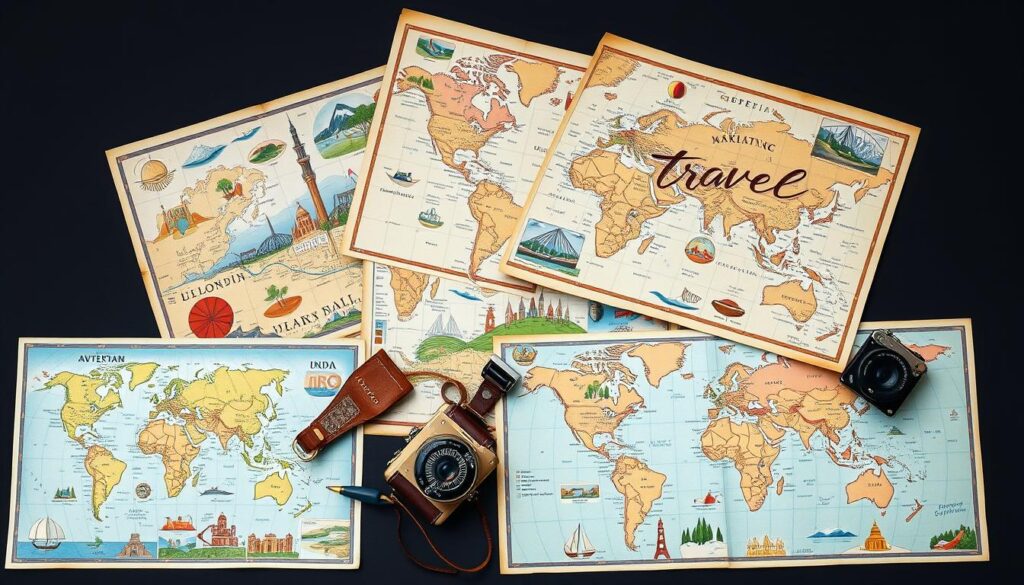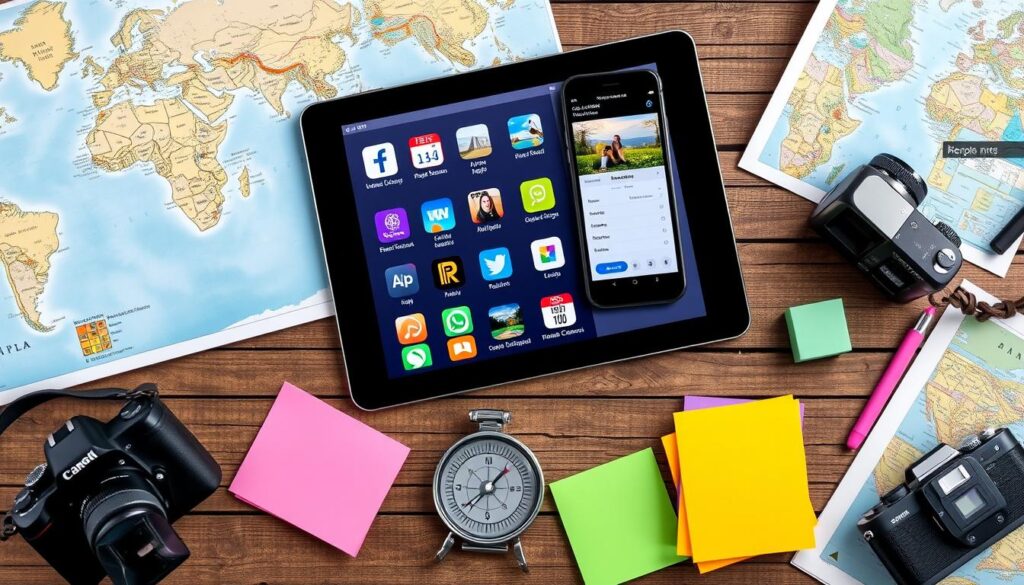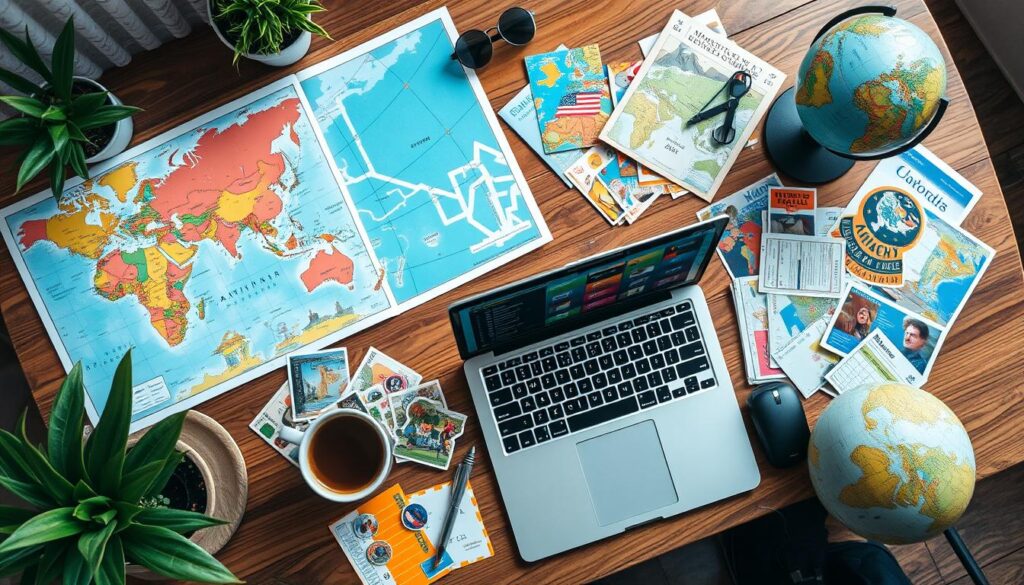Planning a trip can be thrilling. A well-crafted itinerary unlocks unforgettable experiences. It ensures you see must-visit spots while allowing for spontaneity.
A balanced trip strategy helps manage time and budget wisely. It lets you focus on activities matching your interests. A thoughtful guide can turn a good vacation into an extraordinary one.
The goal isn’t to schedule every minute. Instead, create a framework for an enriching journey. Consider local customs, transport options, and dining experiences.
This approach helps craft a smooth-flowing itinerary. It leaves room for magical moments that often define the best trips.
Key Takeaways
- A well-planned itinerary enhances your overall travel experience
- Balance structured activities with free time for exploration
- Prioritize attractions and experiences based on your interests
- Consider local customs and transportation options in your planning
- Leave room for flexibility and unexpected discoveries
- Use your itinerary as a guide, not a strict schedule
Understanding the Importance of a Well-Planned Itinerary
A well-planned itinerary is key to efficient travel. It helps you make the most of your time and avoid mistakes. Let’s explore why careful planning matters for travel optimization.
Maximizing your travel experience
A thoughtful itinerary ensures you don’t miss key attractions. It helps you manage time and create a mix of experiences.
Planning ahead lets you book popular tours early. This way, you can avoid disappointment and long lines.
Balancing activities and relaxation
A stress-free vacation needs the right balance. A good itinerary mixes exciting activities with downtime.
This approach prevents burnout. It allows you to truly enjoy each moment of your trip.
“The art of travel is the art of seeing what is worth seeing, and skipping what is not.” – Howard Hillman
Avoiding common travel pitfalls
Many travel mistakes come from poor planning. A detailed itinerary helps you avoid missing reservations and underestimating travel times.
It’s a valuable tool for travel optimization. It ensures smooth transitions and reduces unexpected problems.
| Common Travel Mistakes | How a Well-Planned Itinerary Helps |
|---|---|
| Overbooking activities | Provides a realistic schedule with built-in breaks |
| Missing must-see attractions | Ensures priority sites are included and pre-booked |
| Underestimating travel times | Accounts for transportation between locations |
| Ignoring local customs or holidays | Incorporates research on local culture and events |
Researching Your Destination: The Foundation of Great Travel Itineraries
Effective destination research is crucial for creating great travel itineraries. It sets the stage for an enriching and authentic experience. Start by exploring reputable travel guides for information on attractions and local customs.
Local insights offer a unique perspective on your destination. Engage with online travel communities and read blogs by expatriates. Connect with locals through social media to discover hidden gems and off-the-beaten-path experiences.
Cultural preparation ensures a smooth and respectful journey. Learn about local etiquette, customs, and traditions. Understanding cultural nuances helps avoid unintentional faux pas and fosters meaningful interactions.
Consider learning basic phrases in the local language. This shows respect and enhances your travel experience. It can also help you connect with locals more easily.
- Explore official tourism websites for up-to-date information
- Read travel blogs for personal experiences and recommendations
- Check travel forums for recent traveler insights
- Research local events and festivals happening during your visit
Thorough research helps you make informed decisions about accommodations and transportation. It allows you to balance must-see attractions with unique experiences. Your itinerary will be tailored to your interests and preferences.
Essential Components of a Comprehensive Travel Plan
A solid travel plan ensures a smooth and enjoyable trip. Let’s explore the core elements of a great itinerary. These components will help you create an unforgettable adventure.
Transportation Logistics
Planning your travel logistics is crucial. Research the best ways to get around your destination. Consider public transit, car rentals, or ride-sharing services.
Book flights, train tickets, or bus passes early. This can help you secure better rates and ensure availability.
Accommodation Arrangements
Booking accommodations early can save you stress and money. Think about your budget, desired location, and needed amenities. Choose from hotels, hostels, vacation rentals, or unique local stays.

Must-See Attractions and Activities
Research the top tourist attractions at your destination. List places you don’t want to miss and check their operating hours. Book tickets for popular sites in advance to avoid long queues.
Dining Experiences and Local Cuisine
Exploring local food is a highlight of any trip. Research traditional dishes and popular eateries. Mix fine dining with street food for a true taste of local culture.
Make reservations for sought-after restaurants to secure your spot.
| Travel Component | Planning Tips |
|---|---|
| Transportation | Compare prices, book early, consider local transit passes |
| Accommodation | Read reviews, check cancellation policies, look for deals |
| Attractions | Pre-book popular sites, check for combo tickets, look for free days |
| Dining | Try local specialties, mix high-end and casual options, ask locals for recommendations |
Carefully consider these essential components when creating your travel plan. Balance practicality with exciting experiences. This approach will set the stage for an amazing journey.
Tailoring Your Itinerary to Different Types of Trips
Adapt your travel plan to suit various styles. Family vacations need kid-friendly activities and relaxation time. Solo travel allows for flexibility and spontaneity. Adventure trips focus on adrenaline-pumping experiences.
Luxury getaways emphasize indulgence and exclusive experiences. Balance is key for family trips. Include educational attractions and fun activities.

Solo travelers can pack diverse experiences into their days. This might include cultural immersion and local interactions. Adventure trips often involve hiking, water sports, or wildlife encounters.
Luxury getaways prioritize high-end dining and spa treatments. They also offer unique cultural experiences. Tailor your itinerary to create unforgettable memories.
“The best itineraries reflect the unique interests and needs of each traveler, creating unforgettable memories.”
Consider these factors when tailoring your itinerary:
- Group size and dynamics
- Physical abilities of travelers
- Budget constraints
- Time of year and weather conditions
- Cultural interests and preferences
| Trip Type | Key Considerations | Sample Activities |
|---|---|---|
| Family Vacations | Kid-friendly, educational, relaxing | Theme parks, museums, beach days |
| Solo Travel | Flexibility, social opportunities | Walking tours, cooking classes, hostels |
| Adventure Trips | Physical challenges, nature experiences | Hiking, scuba diving, zip-lining |
| Luxury Getaways | Exclusivity, pampering, fine dining | Spa treatments, gourmet restaurants, private tours |
Customize your itinerary to match your travel style. This will create a more enjoyable trip. Leave room for spontaneity and unexpected discoveries.
Tools and Resources for Creating and Managing Travel Itineraries
Planning a trip can be both exciting and overwhelming. Modern technology offers many tools to simplify the process. These resources make digital travel planning easy and efficient.
Travel Planning Apps and Websites
Travel apps have changed how we plan trips. Popular options include TripIt, Wanderlog, and Google Trips. These apps organize flights, hotels, and activities in one place.
They make it easy to access your itinerary on-the-go. You can keep all your travel information handy and up-to-date.

Digital vs. Physical Itinerary Management
Digital planning offers several advantages over paper itineraries. It’s easier to update and share with travel companions. You can access your plans from any device.
Many travel apps work offline too. This ensures you’re never lost without internet access.
| Digital Itineraries | Physical Itineraries |
|---|---|
| Easy to update | Tangible keepsake |
| Shareable with others | No battery required |
| Accessible on multiple devices | Immune to tech failures |
Collaborative Planning for Group Trips
Group travel organization can be challenging. Itinerary software like Travefy and Tricount makes it easier. These platforms allow multiple users to contribute to a single itinerary.
Users can vote on activities and split expenses. This approach ensures everyone’s preferences are considered. It leads to a more enjoyable trip for all.
Flexibility and Adaptability in Travel Planning
Travel plans often take unexpected turns. Building flexibility into your itinerary is key. Spontaneous experiences can lead to unforgettable moments.
Unexpected events can disrupt your journey. Flight delays, weather changes, or sudden closures might throw you off course. A flexible mindset helps you handle these surprises with ease.
- Leave some unscheduled time each day for spontaneous exploration
- Research alternative activities in case of unexpected closures
- Book accommodations with free cancellation policies
- Keep a small fund for unforeseen expenses or opportunities
Enjoyable travel balances structure and spontaneity. Having a plan matters, but being open to changes is crucial. This approach can lead to unique, unplanned experiences.
| Rigid Planning | Flexible Planning |
|---|---|
| Stressful when changes occur | Adaptable to unexpected situations |
| Limited to pre-planned activities | Open to spontaneous discoveries |
| Risk of disappointment if plans fall through | Opportunities for unique experiences |
| Strict timeline | Room for extended exploration |
Embracing flexibility helps you navigate travel hiccups smoothly. It allows you to make the most of your journey. Often, the best travel stories come from unplanned adventures!
Conclusion
A well-crafted travel itinerary ensures a memorable and stress-free journey. By following these tips, you can create a balanced schedule. Your plan should maximize experiences while allowing for relaxation.
Successful trip planning involves thorough research and careful consideration of logistics. It also requires adaptability. Your itinerary should include transportation, accommodation, attractions, and dining experiences.
Tailor these elements to suit your travel style and destination. Use modern tools to streamline the planning process. This applies whether you’re organizing a solo adventure or coordinating a group trip.
Remember that flexibility is just as important as preparation. Even the best-planned itineraries may need adjustments. These strategies will help you create unforgettable experiences and handle challenges during your adventures.

